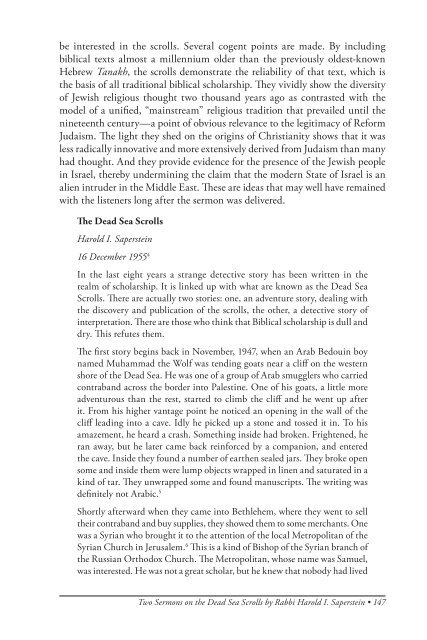The American Jewish Archives Journal, Volume LXI 2009, Number 1
The American Jewish Archives Journal, Volume LXI 2009, Number 1
The American Jewish Archives Journal, Volume LXI 2009, Number 1
Create successful ePaper yourself
Turn your PDF publications into a flip-book with our unique Google optimized e-Paper software.
e interested in the scrolls. Several cogent points are made. By including<br />
biblical texts almost a millennium older than the previously oldest-known<br />
Hebrew Tanakh, the scrolls demonstrate the reliability of that text, which is<br />
the basis of all traditional biblical scholarship. <strong>The</strong>y vividly show the diversity<br />
of <strong>Jewish</strong> religious thought two thousand years ago as contrasted with the<br />
model of a unified, “mainstream” religious tradition that prevailed until the<br />
nineteenth century—a point of obvious relevance to the legitimacy of Reform<br />
Judaism. <strong>The</strong> light they shed on the origins of Christianity shows that it was<br />
less radically innovative and more extensively derived from Judaism than many<br />
had thought. And they provide evidence for the presence of the <strong>Jewish</strong> people<br />
in Israel, thereby undermining the claim that the modern State of Israel is an<br />
alien intruder in the Middle East. <strong>The</strong>se are ideas that may well have remained<br />
with the listeners long after the sermon was delivered.<br />
<strong>The</strong> Dead Sea Scrolls<br />
Harold I. Saperstein<br />
16 December 19554 In the last eight years a strange detective story has been written in the<br />
realm of scholarship. It is linked up with what are known as the Dead Sea<br />
Scrolls. <strong>The</strong>re are actually two stories: one, an adventure story, dealing with<br />
the discovery and publication of the scrolls, the other, a detective story of<br />
interpretation. <strong>The</strong>re are those who think that Biblical scholarship is dull and<br />
dry. This refutes them.<br />
<strong>The</strong> first story begins back in November, 1947, when an Arab Bedouin boy<br />
named Muhammad the Wolf was tending goats near a cliff on the western<br />
shore of the Dead Sea. He was one of a group of Arab smugglers who carried<br />
contraband across the border into Palestine. One of his goats, a little more<br />
adventurous than the rest, started to climb the cliff and he went up after<br />
it. From his higher vantage point he noticed an opening in the wall of the<br />
cliff leading into a cave. Idly he picked up a stone and tossed it in. To his<br />
amazement, he heard a crash. Something inside had broken. Frightened, he<br />
ran away, but he later came back reinforced by a companion, and entered<br />
the cave. Inside they found a number of earthen sealed jars. <strong>The</strong>y broke open<br />
some and inside them were lump objects wrapped in linen and saturated in a<br />
kind of tar. <strong>The</strong>y unwrapped some and found manuscripts. <strong>The</strong> writing was<br />
definitely not Arabic. 5<br />
Shortly afterward when they came into Bethlehem, where they went to sell<br />
their contraband and buy supplies, they showed them to some merchants. One<br />
was a Syrian who brought it to the attention of the local Metropolitan of the<br />
Syrian Church in Jerusalem. 6 This is a kind of Bishop of the Syrian branch of<br />
the Russian Orthodox Church. <strong>The</strong> Metropolitan, whose name was Samuel,<br />
was interested. He was not a great scholar, but he knew that nobody had lived<br />
Two Sermons on the Dead Sea Scrolls by Rabbi Harold I. Saperstein • 147

















